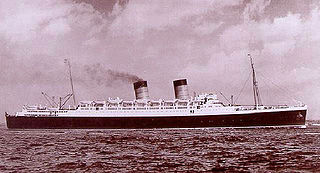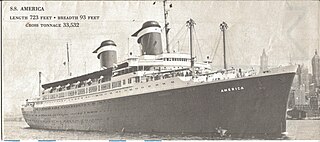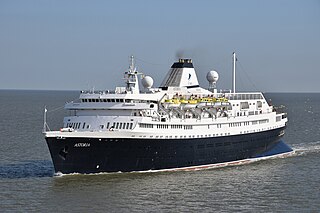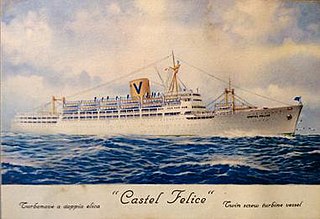
HMS Attacker (D02) was an American-built escort carrier that served with the Royal Navy during the Second World War.

USS Charger (CVE-30) was an escort carrier of the United States Navy during World War II converted from a commercial C3-P&C cargo/passenger liner hull built as Rio de la Plata intended for the Moore-McCormack company's American Republics Line serving the east coast of South America. The ship was requisitioned for conversion to an escort carrier type intended for Royal Navy use and initially commissioned as HMS Charger (D27). Days later the transfer was rescinded with the ship returning to U.S. Navy control to become USS Charger which operated throughout the war as a training ship on the Chesapeake Bay with two ferry missions to Bermuda and Guantánamo Bay, Cuba.

SS Canberra was an ocean liner, which later operated on cruises, in the P&O fleet from 1961 to 1997. She was built at the Harland and Wolff shipyard in Belfast, Northern Ireland at a cost of £17 million. The ship was named on 17 March 1958, after the federal capital of Australia, Canberra. She was launched on 16 March 1960, sponsored by Dame Pattie Menzies, wife of the then Prime Minister of Australia, Robert Menzies. She entered service in May 1961, and made her maiden voyage starting in June. She appeared in the 1971 James Bond film Diamonds Are Forever. In the 1982 Falklands War she served as a troopship. In 1997 the singer and songwriter Gerard Kenny released the single "Farewell Canberra" which was specially composed for the last voyage.

RMS Caronia was a 34,183 gross register tons (GRT) passenger ship of the Cunard Line. Launched on 30 October 1947, she served with Cunard until 1967. She was initially nicknamed the "Green Goddess" after Liverpool's green and white "Green Goddess" trams, and the nickname stuck. She was one of the first "dual-purpose" ships, built both for 2-class transatlantic crossings and all 1st-class cruising. After leaving Cunard she briefly served as SS Caribia in 1969, after which she was laid up in New York until 1974 when she was sold for scrap. While being towed to Taiwan for scrapping, she was caught in a storm on 12 August. After her tow lines were cut, she repeatedly crashed on the rocky breakwater outside Apra Harbor, Guam and broke into three sections.

RMS Aquitania was a British ocean liner of the Cunard Line in service from 1914 to 1950. She was designed by Leonard Peskett and built by John Brown & Company in Clydebank, Scotland. She was launched on 21 April 1913 and sailed on her maiden voyage from Liverpool to New York on 30 May 1914. Aquitania was the third in Cunard Line's grand trio of express liners, preceded by RMS Mauretania and RMS Lusitania, and was the last surviving four-funnelled ocean liner. Shortly after Aquitania entered service, World War I broke out, during which she was first converted into an auxiliary cruiser before being used as a troop transport and a hospital ship, notably as part of the Dardanelles Campaign.

HMAS Sydney (R17/A214/P214/L134) was a Majestic-class light aircraft carrier operated by the Royal Australian Navy (RAN). She was built for the Royal Navy and was launched as HMS Terrible (93) in 1944, but was not completed before the end of World War II. The carrier was sold to Australia in 1947, completed, and commissioned into the RAN as Sydney in 1948.

The RMS Mauretania was an ocean liner that was launched on 28 July 1938 at the Cammell Laird yard in Birkenhead, England, and was completed in May 1939. She was one of the first ships built for the newly formed Cunard-White Star company following the merger in April 1934 of the Cunard and White Star Line. On the withdrawal of the first Mauretania in 1935, to prevent a rival company using the name and to keep it available for the new liner, arrangements were made for the Red Funnel paddle steamer Queen to be renamed Mauretania in the interim.

SS America was an ocean liner and cruise ship built in the United States in 1940, for the United States Lines and designed by the noted American naval architect William Francis Gibbs. It carried many names in the 54 years between its construction and its 1994 wreck: SS America ; troop transport USS West Point; and SS Australis, Italis, Noga, Alferdoss, and American Star. It served most notably in passenger service as America and the Greek-flagged Australis.

TSS Fairstar was a popular Australian-based cruise ship operating out of Sydney for 22 years. Originally completed in 1957 as the British troopship Oxfordshire, it was converted to become the Fairstar in 1964 for immigrant voyages and from December 1974 was permanently engaged in cruising.

Ambience is a cruise ship operated by Ambassador Cruise Line.

MV Columbus was a cruise ship. She was built by Chantiers de l'Atlantique, at their shipyard in Saint-Nazaire, France, and launched in 1988 as Sitmar Fair Majesty. Originally ordered for Sitmar Cruises, with the merger of Sitmar Cruises into Princess, she first entered service with Princess Cruises as Star Princess in 1989. From 1997 to 2003, she served in the P&O Cruises fleet as MVArcadia. She was renamed Ocean Village in 2003 when the brand was established. Ocean Village was the sole cruise ship of the Ocean Village brand after the Ocean Village Two became the Pacific Jewel. In 2010 the Ocean Village brand ceased its operations and she was transferred to P&O Cruises Australia and renamed Pacific Pearl. She served in the P&O Cruises Australia fleet until 2017 when she was sold to Cruise & Maritime Voyages and renamed MV Columbus. Following CMV entering administration in 2020, the Ship was auctioned by CW Kellock & Co. in London on 12 October 2020, for US$5,321,000 to Marios Iliopoulos of Seajets, and some months later resold to scrap in Eleusus Bay. In 2021 she was sold for scrap in Alang, India where she will be beached and dismantled.

RMS Sylvania was an ocean liner built in 1957 by John Brown & Co (Clydebank), in Glasgow, for the United Kingdom-based shipping company Cunard Line. She was the last Cunard Line vessel built specifically for transatlantic crossings. The ship was later heavily rebuilt as a cruise ship, and sailed under the names SS Fairwind, SS Sitmar Fairwind, SS Dawn Princess and SS Albatros before being scrapped in 2004. She was renamed SS Genoa for her last voyage.
The Western Pipe and Steel Company (WPS) was an American manufacturing company that is best remembered today for its construction of ships for the Maritime Commission in World War II. It also built ships for the U.S. Shipping Board in World War I and took part in the construction of the giant Grand Coulee Dam project in the 1930s.

MV Astoria is a ship that was constructed as the transatlantic ocean liner MS Stockholm for Swedish American Line, and rebuilt as a cruise ship in 1993. Ordered in 1944, and commenced service in 1948, at 73 years old, she is the oldest passenger liner still sailing in deep water routes. As Stockholm, she was best known for an accidental collision with Andrea Doria in July 1956, resulting in the sinking of the latter ship and 46 fatalities off the coast of Nantucket, Massachusetts, United States.

USS Aeolus (ID-3005), sometimes also spelled Æolus, was a United States Navy transport ship during World War I. She was formerly the North German Lloyd liner SS Grosser Kurfürst, also spelled Großer Kurfürst, launched in 1899 that sailed regularly between Bremen and New York. At the outset of World War I the ship was interned by the United States and, when the U.S. entered the conflict in 1917, was seized and converted to a troop transport.

SS Orsova, was a British ocean liner, built by Vickers Armstrong in Barrow-in-Furness, England for the Orient Steam Navigation Company for their Great Britain-to-Australia services via the Suez Canal. She was the final development of the 28,000 ton class which began with the SS Orcades of 1948 and continued with the SS Oronsay of 1951. In 1960, in conjunction with the introduction of the new larger and faster Oriana and Canberra, the fleets of Orient and P&O were combined as P&O-Orient Lines, although the Orient ships retained their corn-coloured hulls and sailed under their own house flag. In 1966, P&O acquired the balance of the Orient shares and the Orient Line was discontinued, with Orsova and her fleet mates being transferred to the ownership of the Peninsular & Oriental Steam Navigation Company (P&O), painted white and under the P&O houseflag.

RMS Carinthia was an ocean liner built in 1956 as one of the four Saxonia class ships. She sailed for Cunard Line from her completion until 1968 when she was sold to Sitmar Line, rebuilt into a full-time cruise ship and renamed SS Fairsea. She sailed with Sitmar until 1988, when Sitmar was sold to P&O. She was renamed SS Fair Princess and sailed for Princess Cruises and P&O Cruises until 2000. She was then sold to China Sea Cruises and renamed SS China Sea Discovery. In 2005 or 2006 she was scrapped in Alang, India.

RMS Empress of England was an ocean liner built in 1956-1957 by Vickers-Armstrongs, Newcastle upon Tyne, United Kingdom for the Canadian Pacific Steamships. The ship was launched in 1956; and she undertook her maiden voyage in 1957 and was a near identical sister ship to Empress of Britain.

Sitmar Cruises and its predecessor Sitmar Line were company names derived from the acronym for the Società Italiana Trasporti Marittimi. SITMAR originally was an Italian shipping line founded by Russian émigré Alexandre Vlasov, however the company's headquarters were later transferred to Monaco. Vlasov initially operated cargo services from 1937, gradually replacing these with passenger services from 1947 until 1988, when SITMAR was sold to the Peninsular and Oriental Steam Navigation Company (P&O). After the sale, most of the former SITMAR ships were transferred to the fleet of P&O subsidiary Princess Cruises, while one, TSS Fairstar, became the sole vessel of the newly created P&O-Sitmar Cruises. As of July 2018, one briefly named former SITMAR ship was still operational, as Cruise & Maritime Voyages's Columbus. However, two other vessels originally ordered by SITMAR but delivered to P&O, sailed under the Princess banner before operating from Australia for a number of years, as Pacific Jewel and Pacific Dawn. As of 2021, Pacific Dawn, set to become Ambience is the only survivor, with Columbus and Pacific Jewel being sold for scrap.

Castel Felice was a SITMAR Line liner.



















